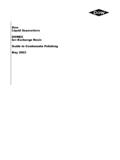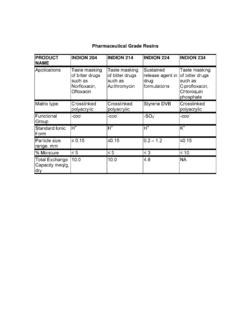Transcription of Ion Exchange Resins - ags.rs
1 Ion Exchange Resins for Metal Plating and Surface FinishingION Exchange RESINSI ntroduction5 Plating Bath Rejuvenation6 Rinse Water Recycling8 Waste Effluent Treatment12 Copper Recovery16 Precious Metal Recovery16 Purification of Galvanizing Solutions17 Summary Table of Ion Exchange Resins18 Contents3 IntroductionIon Exchange Resins (IER) can be used in the metalplating and surface finishing industries in a num-ber of ways: rejuvenation of plating baths andpickling solutions, recycling of rinse waters, as wellas treatment of waste effluents. Environmental regu-lations, economic constraints and the quality of themanufactured metal products influence the decisionto use ion Exchange considerations refer to meetingthe discharge limits for the various metals imposedby government regulations. These vary from countryto country, but in general the limits for discharge ofmetal finishing effluents into the environment rangefrom ppm for the more toxic metals up to 3 ppmfor the less toxic an economic analysis, the costs of treatmentof the plating baths or the rinse waters is compared tothe cost of waste discharge.
2 In some cases it is pos-sible to recover and recycle chemicals for their of the effluents is achieved with the use ofselective Resins , usually of the iminodiacetic acidtype, which selectively remove heavy metals fromsolutions with high Na+and Ca2+ 1 illustrates the overall process of a metalfinishing plant. The major sources of the wastes arethe spent plating baths and the rinse waters. In manyplating industries, different plating baths may beinvolved. For example, chromium, copper, nickelplating are frequently performed in the same , zinc and copper cyanide solutions can be pres-ent in the same plant. The wastes from such platingplants are generally treated 1: Overall Process of a Metal Finishing PlantPlatingBathChemicalTreatmentEffluen tRinseHO26 Chemical TreatmentEffluentDilutionTa n kWaterPlatingBathConcentratedChromic AcidCondenserAmberlyst15 WETR egenerantEvaporatorFigure 2: Rejuvenation Process for Chromium Plating BathPlating Bath RejuvenationChromium plating baths are the most commonexample of a plating bath rejuvenation.
3 Atypical spent chromium plating bath containsabout 300 g/L of chromic acid and 10-25 g/L of Cu2+,Fe3+and Cr3+. The use of a standard cation Exchange resin toremove the metal impurities in order to rejuvenatethe plating bath is not possible under these condi-tions. The H+concentration is so high that the resinwill remain in the H+form, as the equilibrium reac-tion will shift to the left:RSO3-H++ M2+(RSO3-)2M2++ H+In addition, the high oxidative potential of such asolution may rapidly degrade the utilize an IER process, the chromic acid con-centration should be reduced to approximately 100g/L by dilution. A highly crosslinked macroreticularresin such as AMBERLYST 15 WET, which has highoxidative stability, may be suitable for this applica-tion. Under these conditions, the resin has an operat-ing capacity of about eq/LR(1)at 3 BV/h(2) flowrate and a regeneration level of 300 g HCl per liter ofresin using 10-15% HCl (see figure 2).
4 Chromic acid baths used for aluminium anodiz-ing are easier to process because they are lessconcentrated. They contain about 100 gCrO3/L and 10 g Al2O3/L as impurities and thereforeno dilution is necessary. AMBERLYST 15 WET canagain be used in this application. This resin can treatabout 4 BV of such a solution with less than 1 gAl2O3/L average leakage. The same flow rates andregenerant levels are used as for chromium acid solutions can also be rejuvenat-ed with IER. Phosphoric acid is used to passivate andphosphatate iron and steel. These solutions haveupper limits for iron content above which the solu-tion becomes exhausted. A common practice is to remove part of this solu-tion and pass it over a strong acid cation (SAC) resinlike AMBERLYST 15 WET whereby iron isexchanged for H+and the purified phosphoric acidreturns to the process.
5 Operating conditions are sim-ilar as with chromic acid purification describedabove. The resin can remove up to 35 g Fe2+per literof resin. Regeneration is done with 2 BV of 10-15%HCl or 10-15% H2SO4. Another case is the purifica-tion of HCl pickling solutions, contaminated withFe2+and Zn2+. At these chloride concentrations, Zn2+forms an anionic complex, ZnCl42-. Iron (Fe2+) formssuch complexes but at very high HCl concentrations(> 9 N) while Fe3+forms such complexes at about HCl. If both Zn2+and Fe2+are to be removed, Fe2+is first oxidized to Fe3+. The HCl is then purified bypassing through a strong base anion Exchange resinin the chloride form whereby both ZnCl42-and FeCl4-are exchanged for the Cl-. Regeneration is carried outwith water, thereby dropping the HCl concentrationinside the resin beads and breaking the anioniccomplexes allowing Zn2+and Fe3+to come off type strong base anion (SBA) Resins such asAMBERLITE IRA402 Cl, AMBERJET 4200 Cl,AMBERJET 4400 Cl or AMBERLITE IRA400 Clcan be used.
6 The operating capacity depends on boththe Fe3+and HCl concentrations. Generally the higher these concentrations, thehigher the operating capacity. Operating capacitiesup to 35 g Fe per liter of resin can be achieved. Flowrates range from about 2-5 BV/h and regeneration isachieved with 4-8 BV of water. Figure 3 illustratesthe water elution curves for Fe and Zn usingAMBERLITE IRA402 Cl resin.(1)eq/LR: equivalents per liter of resin(2)BV: Bed Volume, volume of solution per volume of resin Figure 3: Water Elution of AMBERLITE IRA402 ClFlow rate : BV/h7 Rinse Water RecyclingDue to the use of different plating baths in thesame plant, the rinse waters can be acidic(plating baths) or basic (cyanide solutions).The treatment of the rinse waters with IER is per-formed on the combined rinse waters (caution shouldbe exercised to insure that the pH is not acidic caus-ing formation of HCN), or separately on the acidicand the basic concentration of the metal impurities shouldrange at about 1-2 meq/L for this process to be eco-nomically feasible.
7 Typically, only the final rinsewaters are recycled, as shown in Figure RinseSpent RegenerantsEffluentRegenerantsPlatingBat hHO2 IonExchangeResinsFigure 4 : Rinse Water Recycling with IERF igure 5 illustrates the recycling of chromic acidplating rinse waters. The composition of suchwaters is similar to that of the plating bathexample given previously, but at a lower concentra-tion. These waters contain around 20 to 100 ppm ofchromates with metal impurities (Cu2+, Fe3+andCr3+) at 5 to 20 ppm levels. The IER system involvesa SAC and a weak base anion (WBA) exchanger. Thewaste regenerant from the WBA resin, which con-tains the recovered chromates, is passed through aSAC exchanger in the H+form which converts thechromates to chromic acid. This is subsequently con-centrated and recycled back to the plating bath.
8 A macroreticular SAC resin such as AMBERLYST16 WET or a gel type resin such as AMBERLITEIR120 H can be used. In some installations,AMBERLYST 16 WET is preferred due to itsmacroreticular structure which gives it increasedoxidative stability compared to the gel type Resins . Inaddition, better removal of cationic detergents isachieved with this Chemical 5 : Acidic Rinse Water Recycling with Chromic Acid RecoverySome chromates (Cr6+) may be reduced on the WBAresin to Cr3+which can then precipitate on the resinas hydroxides. For that reason, it is recommended toperiodically perform an acid clean-up of both theSAC and WBA Resins with 15% considerations apply for recycling rinsewaters from the passivation of steel metals withphosphoric acid. A typical composition of suchwaters may be 50-100 ppm of PO43-with 5-30 ppmof metal impurities such as Fe2+, Mn2+and Zn2+.
9 Aweak base anion Exchange resin such asAMBERLYST A21 can again be used under similaroperating conditions and performance, as basic or mixed rinse waters can contain thefollowing ionic impurities:The flow rate during service cycle can be ashigh as 20 BV/h. The operating capacity to 1 eq/LRwhen the resin is regeneratedwith 100 to 120 g HCl per liter of resin using 6-10 %HCl in a co-current mode. If H2SO4is used as regen-erant, a 150 g per liter of resin level should be usedas a 10% H2SO4solution. Rinse requirements areabout 5 BV. The regeneration level chosen dependson the quality of the recycled water desired. Forremoval of the strong acids, a macroreticular weakbase anion resin such as AMBERLYST A21 is rec-ommended. A typical operating capacity for CrO42-isapproximately 1 eq/LRwhen regenerated with 2 eq of NaOH/LR(4% NaOH solution).
10 Rinsing isdone with 5 BV of decationized water. In general,with the above regeneration levels for the SAC andthe WBA Resins , a conductivity of about 30 S/cm isobtained after the WBA +CrO42-Fe3+Fe(II)(CN)64-Pb2+Fe(III)(CN)6 3-Cu2+Cu(I)(CN)43-Ni2+Ni(CN)42-Zn2+Zn(CN )42-Cd2+Cd(CN)42-PO3-SO42-citrates, acetates, tartratesThe same SAC and WBA Resins can be used in thissystem as in the preceding base anion Resins such as AMBERLYSTA26 OH can be used for this application. In thehydroxide form, these Resins will remove all weakacids that leak through the WBA resin, such as an operating capacity of to eq/LRcan be achieved using a 100 g NaOH per liter of resinregeneration level (4% NaOH solution). Five BV ofdecationized water is used for rinsing. A conductivi-ty of about 5 S/cm is obtained after the SBA regeneration of the WBA and the SBAresins is recommended in order not to mix the CrO42-with the To Chemical OHAmberlystA21 Amberlyst16 WetFigure 6: Mixed or Alkaline Rinse Waters Recycling(3) Arden and F.








